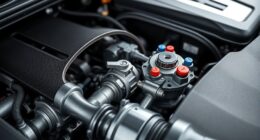Your car’s cooling system keeps your engine running smoothly by managing heat through parts like the radiator and thermostat. The radiator cools the engine’s coolant, while the thermostat controls when coolant flows to maintain the right temperature. Regular maintenance ensures these components work efficiently, preventing overheating and costly damage. Understanding how they function helps you keep your vehicle in top shape—keep exploring to learn more about how these vital parts keep your engine cool.
Key Takeaways
- The radiator dissipates heat from coolant to prevent engine overheating.
- The thermostat regulates coolant flow, maintaining optimal engine temperature.
- Regular radiator maintenance includes inspecting for leaks, flushing, and coolant replacement.
- A faulty thermostat can cause engine overheating or running too cold.
- Proper coolant type and sealed radiator cap are essential for efficient cooling system operation.

Your car’s cooling system plays a pivotal role in preventing the engine from overheating, guaranteeing it runs smoothly and efficiently. At the heart of this system is the radiator, which dissipates heat from the coolant as it circulates through the engine. To keep everything functioning properly, you need to understand the different coolant types and how radiator maintenance affects overall performance. Coolant, also called antifreeze, isn’t just a liquid that keeps your engine from freezing in winter; it also prevents corrosion and helps transfer heat effectively. There are several coolant types available, typically based on the chemical formulation, such as ethylene glycol or propylene glycol, and some contain additives for corrosion resistance or improved heat transfer. It’s crucial to use the right coolant type specified by your vehicle manufacturer because incompatible coolants can cause damage to your radiator and engine components over time.
Maintaining your radiator is equally significant as choosing the right coolant. Radiator maintenance involves regularly inspecting for leaks, corrosion, or debris buildup that can obstruct airflow and reduce cooling efficiency. When you flush your radiator and replace the coolant, you remove any contaminants or rust that can clog passages and impair heat transfer. This process also gives you a chance to check the radiator cap for proper sealing, which is essential for maintaining the correct pressure in the cooling system. A loose or damaged cap can lead to coolant loss and overheating issues. Additionally, inspecting hoses for cracks or leaks ensures coolant circulates properly without interruption. Remember, neglecting radiator maintenance can lead to overheating, engine damage, or costly repairs.
Your thermostat is another key component that works closely with the radiator. It acts as a gatekeeper, regulating when coolant flows to the radiator based on the engine’s temperature. When the engine warms up, the thermostat opens, allowing coolant to flow through the radiator for cooling. Once the engine reaches its ideal temperature, the thermostat closes slightly to maintain consistent operating conditions. If your thermostat sticks open or closed, it can cause your engine to run too cold or overheat, respectively. Understanding how your thermostat functions can help you diagnose cooling system issues early. Regular inspection and, if necessary, replacement of the thermostat ensure it operates correctly, contributing to the overall health of your cooling system.
Frequently Asked Questions
How Often Should I Flush My Car’s Cooling System?
You should flush your car’s cooling system every 30,000 to 50,000 miles or roughly every 2 to 5 years, depending on your vehicle’s make and model. Following a proper flushing schedule helps prevent corrosion and guarantees coolant replacement is effective. Regular flushing keeps your radiator and thermostat functioning smoothly, reducing the risk of overheating. Check your owner’s manual for specific recommendations tailored to your car.
Can a Faulty Thermostat Cause Engine Overheating?
A faulty thermostat can absolutely cause your engine to overheat, leading to coolant leaks and even severe engine damage. When the thermostat fails, it either stays closed or open, disrupting coolant flow. This blockage traps heat, making your engine run hotter than a volcano’s core. If you notice overheating, check for thermostat failure and coolant leaks pronto—ignoring these signs can turn small problems into costly repairs.
What Are Signs of a Failing Radiator?
You’ll notice signs of a failing radiator if the coolant color looks rusty or dirty, indicating corrosion or contamination. Watch for frequent overheating, coolant leaks, or low coolant levels under the radiator cap. If the radiator cap isn’t sealing properly, it can cause overheating too. These issues point to a radiator that’s not functioning correctly, and you should get it inspected and repaired promptly to prevent engine damage.
Is It Safe to Drive With a Leaking Cooling System?
You shouldn’t drive with a coolant leak because it can lead to engine overheating and serious damage. Leaking coolant suggests your radiator needs repair, and continuing to drive can worsen the problem. If you notice a coolant leak, pull over safely and avoid driving until you get your radiator repaired. Addressing the leak promptly prevents costly repairs and keeps your engine running smoothly.
How Does Altitude Affect My Car’s Cooling System?
Sure, towering at high altitudes might seem glamorous, but it actually messes with your car’s cooling efficiency. The thinner air reduces cooling effectiveness, causing your engine to run hotter. Altitude effects mean your radiator and thermostat work harder to keep things cool, risking overheating. So, while mountain views are stunning, your car’s cooling system struggles to keep up in the thin air—making high-altitude drives a real test.
Conclusion
Now that you understand how your car’s radiator and thermostat work together to keep your engine cool, you’re better equipped to spot potential issues before they become costly repairs. Regular maintenance guarantees your cooling system runs smoothly, saving you time and money. Remember, your car’s health depends on your attention to its cooling system—aren’t you willing to give it the care it deserves to keep you on the road?









